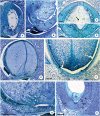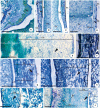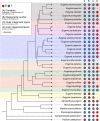The anatomy of the seed-coat includes diagnostic characters in the subtribe Eugeniinae (Myrteae, Myrtaceae)
- PMID: 36275536
- PMCID: PMC9580042
- DOI: 10.3389/fpls.2022.981884
The anatomy of the seed-coat includes diagnostic characters in the subtribe Eugeniinae (Myrteae, Myrtaceae)
Abstract
The subtribe Eugeniinae comprises of two genera, Eugenia (ca. 1,100 species) and Myrcianthes (ca. 40 species). Eugenia is the largest genus of neotropical Myrtaceae and its latest classification proposes 11 sections. This study describes the seed anatomy of forty-one species of Eugeniinae in order to provide possible diagnostic characteristics. Following standard anatomical techniques, flower buds, flowers, and fruits were processed and analyzed using microtome sections and light microscopy. The phylogeny used the regions ITS, rpl16, psbA-trnH, trnL-rpl32, and trnQ-rps16, following recent studies in the group. Ancestral character reconstruction uncovered that: (1) the ancestral ovule in Eugeniinae was campylotropous (98.9% probability), bitegmic (98.5% probability), and unitegmic ovules arose on more than one lineage independently within Eugenia; (2) the pachychalazal seed-coat appeared with a 92% probability of being the ancestral type; (3) non-lignified seed-coat (24,5% probability) and aerenchymatous mesotesta (45.8% probability) are diagnostic characters in Myrcianthes pungens (aerenchymatous mesotesta present in the developing seed-coat) and in the species of E. sect. Pseudeugenia until the species of E. sect. Schizocalomyrtus and it is the type of seed-coat that predominates in most basal sections on the tree; (4) the partial sclerification (only in the exotesta-exotestal seed-coat) is mainly observed in species of E. sect. Excelsae, E. sect. Jossinia (group X), and E. sect. Racemosae (22.2% probability); (5) and in the species of the recent lineages of Eugenia, with a probability of 27.2%, predominate the exomesotestal or testal construction of the seed-coat [character observed in almost all species analyzed of E. sect. Jossinia (group Y) and E. sect. Umbellatae]. A dehiscent fruit is considered as a plesiomorphic state in Myrtaceae; the ancestor of this family had seeds with a completely sclerified testa, and the other testa types described for the current species with dehiscent and indehiscent fruits are simplified versions of this ancestral type. Perhaps, this means that the sclerified layers in the seed-coat have remained in whole or in part as a plesiomorphic condition for taxa with a capsule and bacca. Maintaining the plesiomorphic condition may have represented a selective advantage at some point in the evolutionary history of the family and its groups.
Keywords: Myrcianthes; Pseudeugenia; Racemosae; Umbellatae; pachychalaza; perichalaza; testa; trait evolution.
Copyright © 2022 Sbais, Machado, Valdemarin, Thadeo, Mazine and Mourão.
Conflict of interest statement
The authors declare that the research was conducted in the absence of any commercial or financial relationships that could be construed as a potential conflict of interest.
Figures






 Eugenia sect. Pseudeugenia;
Eugenia sect. Pseudeugenia; E. sect. Hexachlamys;
E. sect. Hexachlamys; E. sect. Eugenia;
E. sect. Eugenia; E. sect. Pilothecium;
E. sect. Pilothecium; E. sect. Phyllocalyx;
E. sect. Phyllocalyx; E. sect. Schizocalomyrtus;
E. sect. Schizocalomyrtus; E. sect. Jossinia;
E. sect. Jossinia; E. sect. Racemosae;
E. sect. Racemosae; E. sect. Speciosae;
E. sect. Speciosae; E. sect. Umbellatae).
E. sect. Umbellatae).
 Eugenia sect. Pseudeugenia;
Eugenia sect. Pseudeugenia; E. sect. Hexachlamys;
E. sect. Hexachlamys; E. sect. Eugenia;
E. sect. Eugenia; E. sect. Pilothecium;
E. sect. Pilothecium; E. sect. Excelsae;
E. sect. Excelsae; E. sect. Phyllocalyx;
E. sect. Phyllocalyx; E. sect. Schizocalomyrtus;
E. sect. Schizocalomyrtus; E. sect. Jossinia;
E. sect. Jossinia; E. sect. Racemosae;
E. sect. Racemosae; E. sect. Speciosae;
E. sect. Speciosae; E. sect. Umbellatae).
E. sect. Umbellatae).References
-
- Anderson L. C. (1963). Studies on Petradoria (Compositae): Anatomy, cytology, taxonomy. Trans. Kansas Acad. Sci. 66 632–684. 10.2307/3626813 - DOI
-
- Andrade R. N. B., Ferreira A. G. (2000). Germinação e armazenamento de sementes de uvaia (Eugenia pyriformis Camb.) Myrtaceae. Rev. Bras. Sem. 22 118–125. 10.17801/0101-3122/rbs.v22n2p118-125 - DOI
-
- Beech E., Rivers M., Oldfield S., Smith P. P. (2017). Global tree search: The first complete global database of tree species and country distributions. J. Sustain. For. 36 454–489. 10.1080/10549811.2017.1310049 - DOI
-
- Berg O. (1855-1856). Revisio Myrtacearum Americae. Linnaea 27 1–472.
-
- Berg O. (1857). “Myrtaceae,” in Flora brasiliensis, Vol. 14 ed. von Martius C. F. P. (Munich: Monachii et Lipsiae; ), 1–468. 10.5962/bhl.title.454 - DOI
LinkOut - more resources
Full Text Sources

